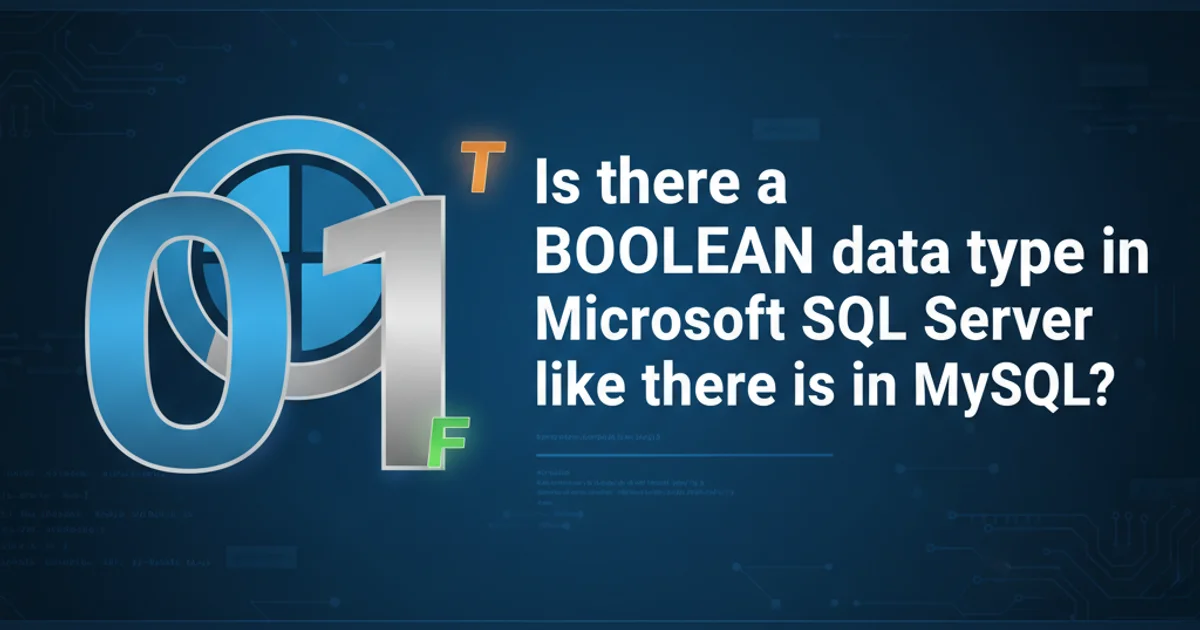Is there a Boolean data type in Microsoft SQL Server like there is in MySQL?
Categories:
Boolean Data Types in SQL Server: Understanding BIT and Beyond

Explore how Microsoft SQL Server handles boolean logic, focusing on the BIT data type and common workarounds for representing true/false values, contrasting it with MySQL's BOOLEAN.
Developers familiar with other database systems like MySQL or programming languages often look for a direct BOOLEAN data type in Microsoft SQL Server. While SQL Server does not have an explicit BOOLEAN type, it provides robust alternatives to handle true/false or yes/no logic effectively. This article will delve into the primary method for representing boolean values in SQL Server, the BIT data type, and discuss other common practices.
The BIT Data Type: SQL Server's Boolean Equivalent
Microsoft SQL Server uses the BIT data type to store boolean-like values. A BIT column can store 0, 1, or NULL. This is the closest equivalent to a boolean type, where 1 typically represents TRUE and 0 represents FALSE. It's highly efficient, as SQL Server can optimize storage for multiple BIT columns within a single byte if they are in the same table.
CREATE TABLE Products (
ProductID INT PRIMARY KEY,
ProductName NVARCHAR(255),
IsActive BIT NOT NULL DEFAULT 0,
IsInStock BIT
);
INSERT INTO Products (ProductID, ProductName, IsActive, IsInStock)
VALUES
(1, 'Laptop', 1, 1),
(2, 'Mouse', 1, 0),
(3, 'Keyboard', 0, NULL);
Creating a table with BIT columns and inserting sample data.
BIT column should be NOT NULL. If a NULL value is not a valid state for your boolean logic (e.g., 'active' or 'inactive' but never 'unknown'), make it NOT NULL and provide a DEFAULT value.Querying BIT Columns
Querying BIT columns is straightforward. You can directly compare them to 0 or 1. SQL Server implicitly converts TRUE and FALSE literals to 1 and 0 respectively in some contexts, making queries intuitive.
SELECT ProductName, IsActive
FROM Products
WHERE IsActive = 1; -- Or WHERE IsActive = TRUE;
SELECT ProductName, IsInStock
FROM Products
WHERE IsInStock = 0; -- Or WHERE IsInStock = FALSE;
SELECT ProductName
FROM Products
WHERE IsInStock IS NULL;
Examples of querying BIT columns for TRUE, FALSE, and NULL values.
flowchart TD
A[Application Logic] --> B{"Is Product Active?"}
B -- Yes (TRUE) --> C[SQL Server Query: WHERE IsActive = 1]
B -- No (FALSE) --> D[SQL Server Query: WHERE IsActive = 0]
C --> E[Retrieve Active Products]
D --> F[Retrieve Inactive Products]Flowchart illustrating how application logic translates to SQL Server BIT column queries.
Alternatives and Considerations
While BIT is the standard, some developers might use other data types for boolean-like flags, especially in legacy systems or specific integration scenarios. However, BIT is generally the most efficient and recommended approach.
TINYINT: Can store values from 0 to 255. While0and1can represent boolean states, it uses more storage thanBIT(1 byte per column) and allows for a wider range of values, which might lead to data integrity issues if not properly constrained.CHAR(1): Can store 'Y'/'N' or 'T'/'F'. This is less efficient for storage and requires string comparisons, which are slower than numeric comparisons. It also introduces potential case-sensitivity issues.
It's crucial to maintain consistency in your application layer when interacting with BIT columns. Map TRUE to 1 and FALSE to 0 reliably.
TINYINT or CHAR(1) for boolean flags unless there's a compelling reason (e.g., compatibility with an external system that mandates it). BIT is optimized for this purpose and ensures better data integrity and performance.